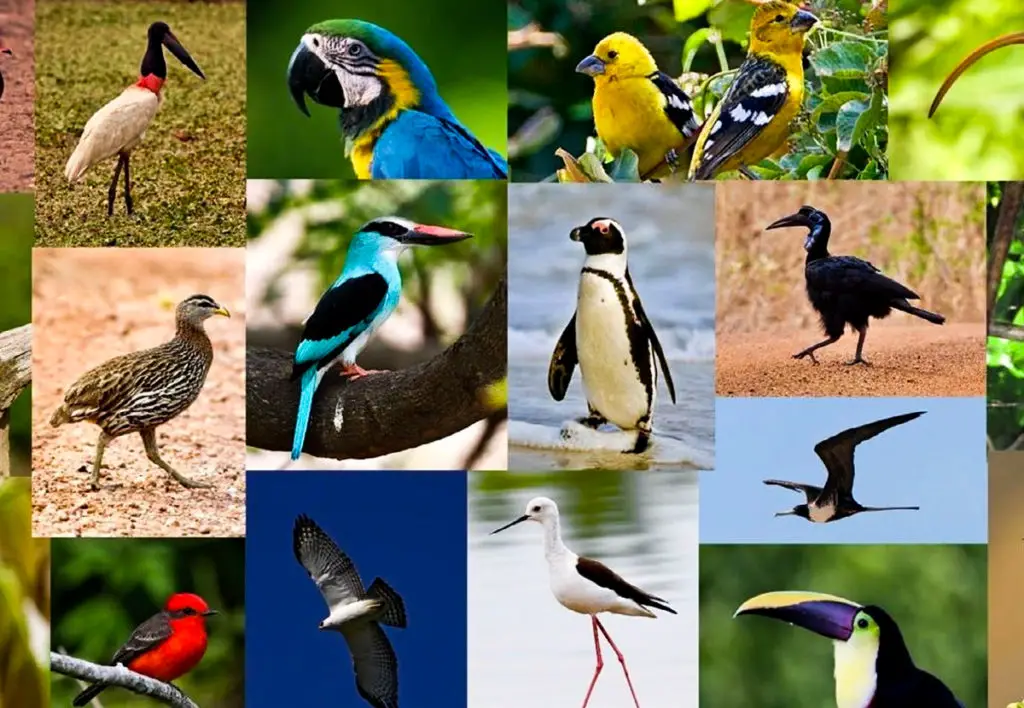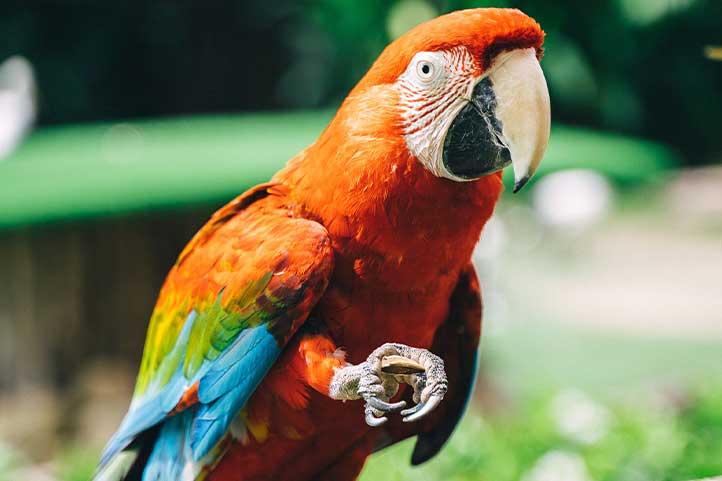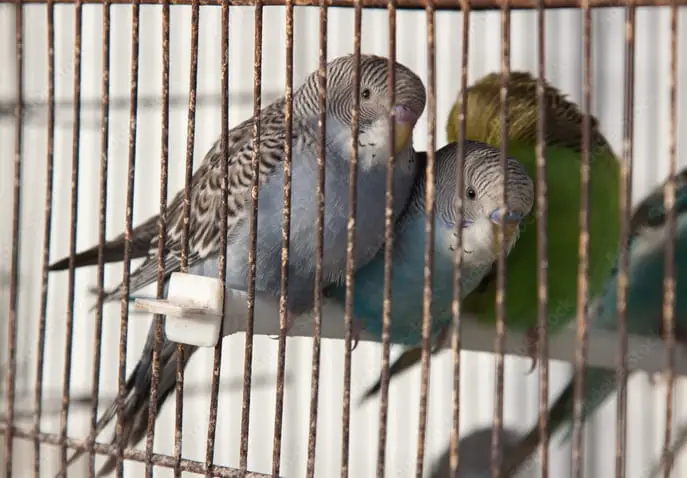Translated by Nick R
There are more than 18,000 species of birds worldwide and they have conquered several environments with specific characteristics that make them unique in an almost infinite mosaic of colors and shapes. But how are birds classified? What types of birds are there? Find out here.
Table of Contents
General characteristics of birds
Like other animals, birds have particular features that group together a variety of species in a large universe. For this reason, birds can be classified in a thousand different ways, based on many factors, such as physical and ethological (behavioral) traits.
Here are the 10 main characteristics of birds:
- Birds are a group belonging to the kingdom Animalia and the phylum Chordata, subphylum Vertebrata. In other words, they are vertebrate animals; that is, with spines and bones.
- They are heterotrophic animals, i.e., they don’t produce their own food. As if they were plants!
- Although they are close relatives of cold-blooded reptiles. Birds are warm-blooded mammals.
- They have a four-chambered heart.
- They are covered with feathers.
- They have no teeth, but a beak.
- Birds reproduce by laying eggs.
- The vast majority of species are monogamous.
- They have four limbs, two wings and two legs (bipedal).
- Birds have a skeleton with hollow bones, hence their ability to fly (although not all of them fly).
Many things are in common, but how to classify them based on their differences?
Types of Birds
Types of birds according to their taxonomy
Birds can be classified according to their family tree, by identifying their relatives. This is technically called a phylogenetic tree. In this tree, morphological and ethological similarities are determined over millions and millions of years of evolution (taxonomy). Here are some of the most important taxonomic groups:
Passeriformes
Many of the species in this order are songbirds and our favorite pets. Yes, surely, if you have had domestic birds, you had one of these at home. Among the most prominent species are canaries, European goldfinches, and zebra finches, many of them songbirds and granivores.
Psittaciformes
In this large group are all the “parrot-like” or “parrot-shaped” species. With such an explanation, I think you already know which species belong to this clade. The “quasi-parrots” include royal parrots and other very distinctive species such as the macaw, Australian parakeets, and lovebirds.
Columbiformes
Here we encounter many species, several of which are well-known in the natural world and by naturalists and bird lovers. But, if we talk about a classic and well-known representative of this group, you just have to look around you, and you are sure to be next to one or several specimens. These birds are characterized by being small and flying, and all of them enjoy seeds and vegetables. Among the almost 350 species that currently exist, pigeons and turtledoves are the most representative birds.
Galliformes
This one is very easy. Galliformes equals chickens. Yes, I know you knew that. Chickens are part of this group along with more than 280 other species, but their domestication has been intensive. For this reason, hens and their husbands: roosters, have gained the recognition of the whole group. To mention a few species, among this group are quails, partridges, and both peacocks and domestic turkeys.
Anseriformes
This group also includes poultry, but with one particularity: they are aquatic. There are 160 species of birds belonging to the Anseriformes, including ducks, geese, and beautiful swans.
Falconiformes
Here we find the great diurnal hunters of nature, the predators of the predators, and the top eaters of the food chain: eagles and hawks. Of course, we cannot leave out their scavenger brothers, the vultures. This group of birds includes more than 300 species worldwide.
Strigiformes
Well, if the Falconiformes are the top diurnal hunters, the Strigiformes are the top predators of the night. Just as you read it, here you’ll find the nocturnal raptors, which evolved in an analogous way to the diurnal raptors.
Pelecaniformes
Approximately 70 species belong to this group, including the most representative bird: the pelican. Among the Pelecaniformes, you also find slender herons. These animals enjoy eating fish.
…And there are many more groups.
Types of birds according to their anatomy
By their size
Well, when we talk about size, the classification is much simpler. We can simply classify birds into small, medium, and large.
Small birds
It groups the species with sizes smaller than 20cm, which includes a great part of passerines such as the canary, the Australian parakeets, and the European goldfinches, among others. Many of these specimens are companion birds.
Large birds
These are all species that exceed 30 cm in length, this is an approximation made from the point of view of domestic species since there are very large birds.
Medium birds
While the medium birds are a little standardized measure and serve rather differentiate the small birds from the big ones. If we give a specific measurement, we would speak of a length between 20 and 30 centimeters.
By their beak
A distinctive feature of birds is their mouth, which lacks teeth. But, instead, it has a beak that serves for many things; we can say that it is a multipurpose tool used to eat, climb and grab things. In addition, it is also used for defense and, in some cases, for building and opening holes. Some experts have named the bird’s beak as another limb. This powerful tool has many forms depending largely on the animal’s diet. Here are the most representative ones:
- Generalist.
- Insectivorous.
- Granivorous.
- Nectarivore.
- Filter feeders.
- Piscivore.
- Bird of prey.
- Diver.
- Limicolous.
- Frugivore.
- Pico-bag.

Curious fact
One example of a strange beak is the shoebill, the shape of its beak doesn’t fit into any of the above categories. Literally, its beak looks like a shoe, and the bird has two curved jaws that allow it to extract seeds from pine cones.
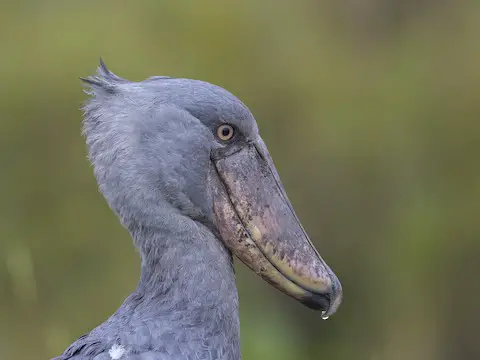
By their legs
Toes arrangement
Birds are classified according to the arrangement of their toes:
- Anisodactyla: three toes facing forward and one backward.
- Syndactyly: same as Artiodactyl, but with the middle toes fused.
- Zygodactyl: two fingers forward and two backward.
- Heterodactyl: same as zygodactyl, but the back toes are the first and second toes.
- Pamprodactyla: four toes forward.
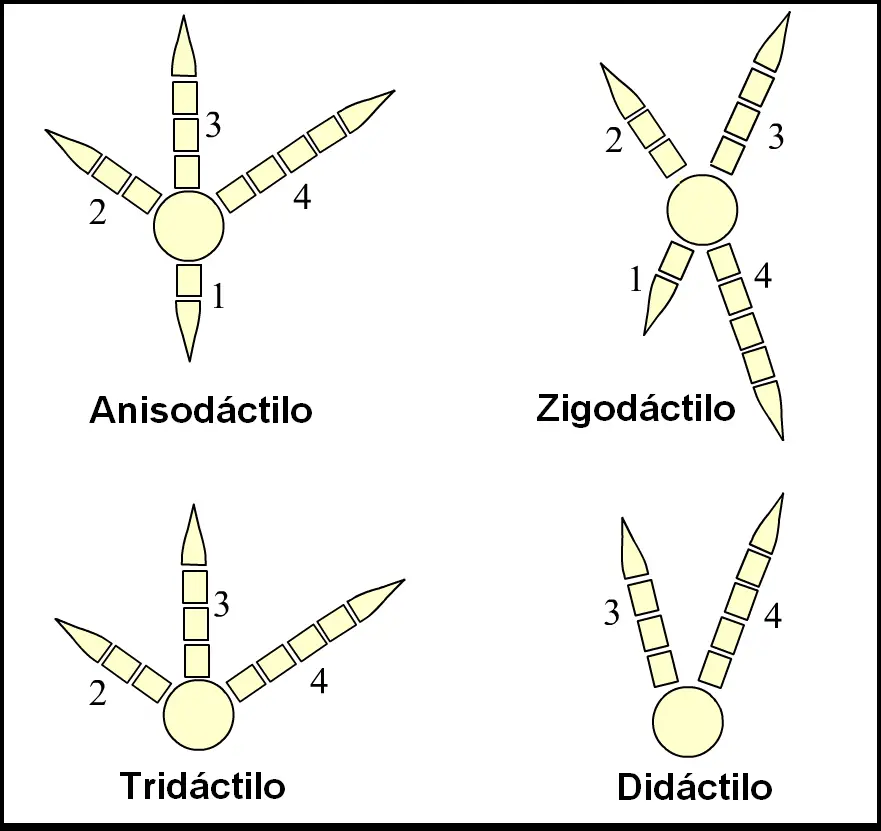
Number of toes
Depending on how many toes the bird has, they can be classified as:
- Didactyla (two toes)
- Tridactyla (three toes).
- Tetradactyla (four toes).
Toe shape
The legs can also be classified by their shape:
- Clawed feet (raptors).
- Webbed feet (aquatic).
- Lobed feet (semi-aquatic).
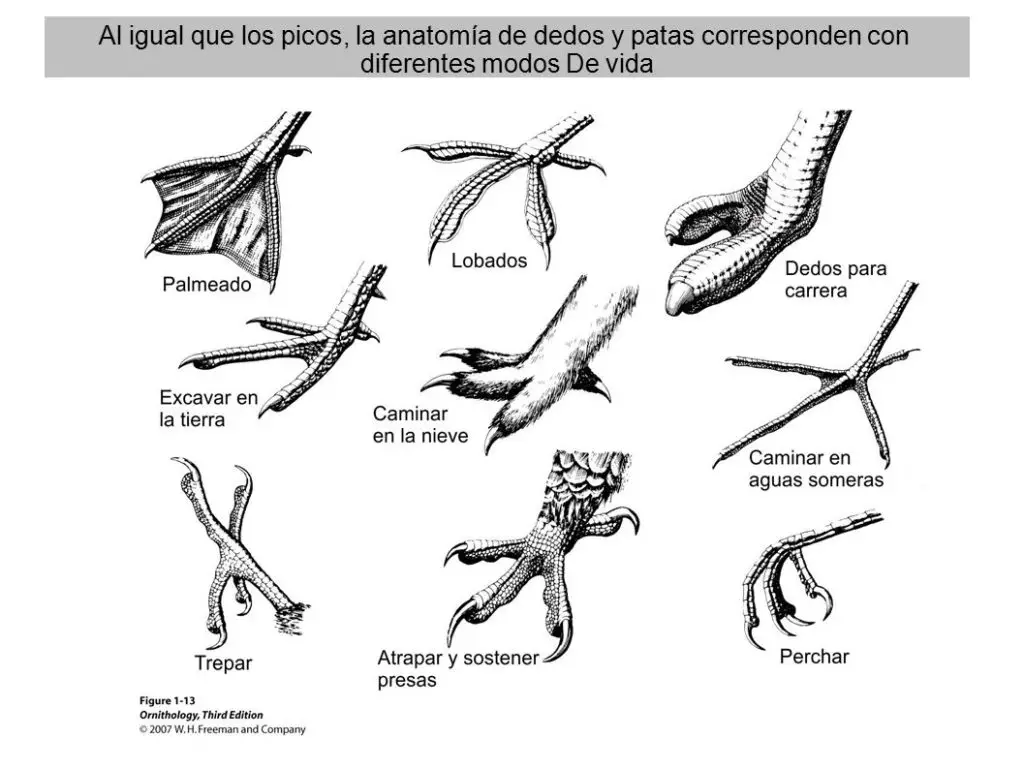
Types of birds according to their feeding habits
Herbivores
Granivorous birds base their diet on seeds, although they can eat other fresh foods such as fruits and vegetables as well; among them, parrots, toucans, canaries and the great majority of pet birds.
Carnivores
When we talk about carnivorous birds we automatically refer to nature’s most recognized winged hunters: raptors and scavengers since these birds feed on the flesh of their prey, either fresh or dead.
Omnivores
Omnivorous birds are more easygoing, they are not so demanding and eat a little bit of everything. Omnivorous birds include all species that eat seeds, fruits, and vegetables as well as insects. Sparrows and chickens are two examples of insectivorous birds that eat seeds.
Insectivores
They feed entirely on insects such as, for example, swallows, a species that feasts on all types of invertebrates.
Types of birds according to their habits
By their mobility
It may seem strange to you, but birds can also be classified according to their mobility. Did you think that, just because they have wings, they all fly? Well, no, there are three types:
- Flying (almost all of them).
- Runners (ostriches).
- Swimmers (ducks).
According to their labor hours
Birds have very difficult jobs and have to assign a specific schedule to complete their functions optimally, so some birds work day shifts and others work night shifts. In the animal kingdom, there are two types of birds according to their working hours:
- Diurnal.
- Nocturnal.
By their relationships
Sexual
The birds’ intimate relationships have several fields, one of which is the sexual aspect of their life as a couple. Birds can be classified into two types:
- Monogamous (a single pair).
- Polygamous (many pairs).
Although some studies indicate that 95% of birds are monogamous, according to the BBC, approximately 90% of bird species are faithful and never betray their spouse. We are talking about an animal that suffers neither scandals nor claims, birds are true examples. Females don’t care much about betrayals, they choose their partners forever.
Most girls would definitely love to have a bird for a boyfriend…
Social
Most birds are animals that don’t like to be alone, except for birds of prey, which remain alone most of their lives. Birds can be classified into several types of social groups according to size and the way they interact:
- Flocks are large groups of small birds, approximately more than 30 individuals, often reaching 50 birds.
- Flocks are social groups of smaller birds. Sometimes flocks and congregations are used indiscriminately as if they were the same thing, but flocks are groups of about 30 individuals.
- Communes are communities joined by several nests. It is a term normally used to refer to the social groups formed by monk parakeets or common parakeets.
Types of birds by habitat
By their residence
Migratory
These are all birds that change location on a seasonal basis. Migratory birds travel long distances in search of better conditions for breeding and feeding. Many species native to Europe and other seasonal areas belong to this group.
Sedentary
In contrast to migratory birds, sedentary birds stay in one place without moving in search of better conditions. Many species from tropical areas can be included here.
By their ecosystem
Aquatic
Aquatic birds are all species that live for a long time in the water, as is the case of penguins, which are animals with a body evolved to swim rather than fly, excellent swimmers!
Amphibians
Amphibians? Birds with the face of a toad or something like that? Not exactly. Actually, when I talked about amphibious birds, you should know that I am referring to all species that like both land and water, they can live in both worlds without a problem. Examples: coots and grebes.
Seabirds
As for seabirds, the only thing that differentiates them from aquatic and amphibious birds is that, although they also love to get wet, they love the salt water of the sea more than the freshwater. Example: gannets.
Arboreal birds
These are flying birds, but they are called arboreal because they spend a lot of time in trees. Here we could include many granivorous and frugivorous species, which spend their time in the branches.
Crawlers
In this group belong the species of birds that are not very good at flying and stay a long time on the ground, as kiwis do.
Urban
These are all birds that like to live in cities, such as pigeons and the Argentine parrot.
Another way of classifying birds has to do with you and me…
Types of birds according to their relationship with humans
Wild birds
Wild birds are all birds that live in their natural habitat, without human intervention, and survive under the conditions of nature.
Exotic birds
Exotic birds are all birds that are misplaced How so? Yes, just as you read it, exotic birds are all species that are found in a place where they do not belong, after being moved by humans.
Is it difficult to take care of exotic birds?
Domestic birds
Many of the birds that were or are part of the previous two groups belong here as well. Domestic birds are animals that interact with humans directly, being poultry or companion birds, that is, pets.
You may also be interested in
The diversity is wide and at the same time limited, but the beauty of birds is infinite!
Did you know that Colombia is the country with the greatest bird biodiversity in the world? Discover the wonderful experience of spotting over 1,900 bird species in their natural habitat by organizing a custom vacation to Colombia with expert local guides.
